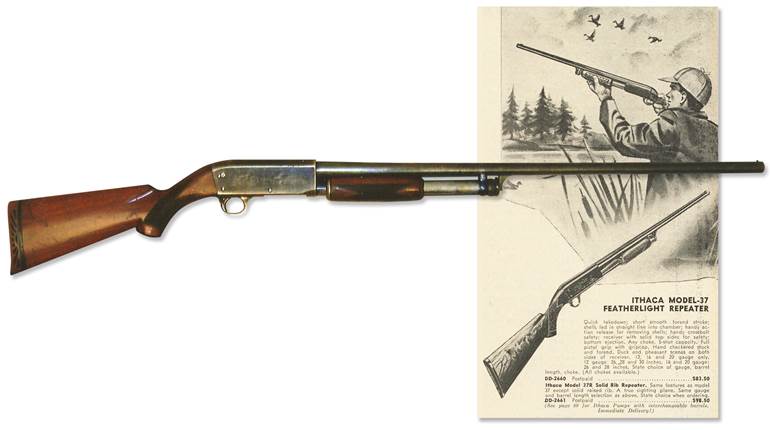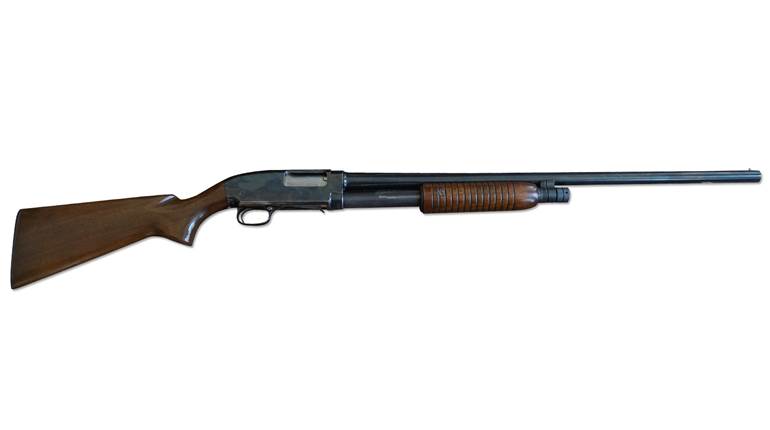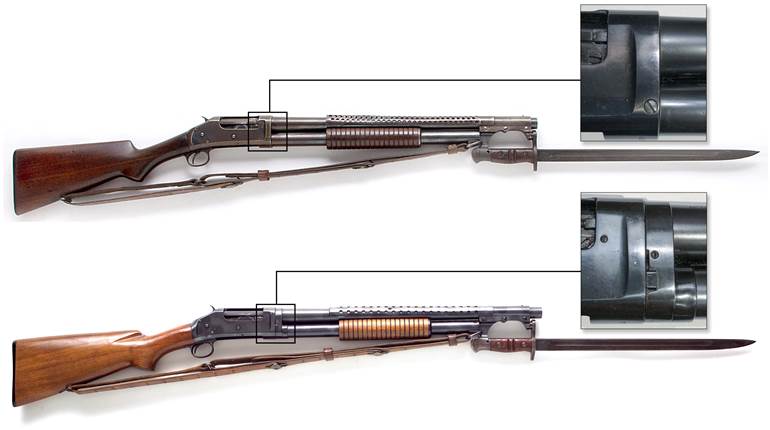
Shotguns have had a long, but often unheralded, tenure of service with America’s armed forces. Even before the Revolutionary War, smoothbore flintlock “fowling pieces” were frequently pressed into service in the hands of militia and other irregular troops. Shotguns were often employed, particularly by Confederate cavalrymen, during the American Civil War. Likewise, shotguns accompanied troops during the western expansion from the late 1860s through the 1880s.
A few shotguns were acquired by the military during this period for “foraging” use, such as hunting birds and other small game to supplement the typical salt pork and hardtack fare. In the immediate aftermath of the Spanish-American War of 1898, the U.S. military procured shotguns specifically for combat purposes when a couple hundred commercial Winchester Model 1897 slide-action “riot” shotguns (20" barrel) were issued to American soldiers fighting Moro tribesmen in the Philippines.
While never a large part of our military small arms arsenal, increasing numbers of shotguns saw service in all subsequent U.S. military conflicts. During World War I, a version of the Model 1897 fitted with a ventilated metal handguard and bayonet adapter was issued for combat use, along with a smaller number of similarly modified Remington Model 10 shotguns. Dubbed “trench guns,” these arms produced during World War I remained in service with the U.S. military between the wars, but no new combat shotguns were manufactured after cancellation of the 1918 contracts. After the Armistice, civilian gunmakers concentrated on rifles and shotguns for the civilian sporting/hunting market.

Due to the growing popularity of the Winchester and Remington slide-action shotguns, Ithaca Gun Co. sought a gun of this type to keep pace with its two major competitors. In 1937, Ithaca introduced its first repeating shotgun, the Model 37. The gun was an improved version of the John Browning-designed Model 17 that had been a popular seller for the Remington Arms Co.
The design differed from most other slide-action shotguns as the shells were loaded and ejected from the bottom of the receiver rather than the bottom-loading and side-port ejection configuration found on most of the competing designs. This feature appealed to many buyers, and the Model 37 soon became known for its craftsmanship and reliability. From the time of its introduction until the eve of America’s entrance into World War II, Ithaca focused on commercial sales of the Model 37, and the company made little effort to attract law enforcement or military customers.
Nonetheless, with the ever-increasing likelihood that the United States would be drawn into the war raging in Europe, the U.S. Army Ordnance Dept. began preparations to procure shotguns for military use. It was envisioned that such arms would soon be needed for training and combat purposes. To that end, the U.S. Army Ordnance Dept. issued Order No. 17074 on Aug. 7, 1941, which standardized the following shotguns for “riot and sporting use”: Winchester Model 97, Winchester Model 12, Ithaca Model 37, Remington Model 31 and Savage M620.

On Nov. 11, 1941, (less than a month before the attack on Pearl Harbor), the U.S. Ordnance Dept. placed orders with Winchester Repeating Arms Co. for 1,494 Model 97 “trench guns,” the first new military combat shotguns to be procured since the end of World War I.
Anticipating additional orders from the government for combat shotguns as well, Ithaca designed a “trench gun” version of its Model 37 riot gun (20" barrel) fitted with a handguard/bayonet adapter very similar to the Winchester design. Since the Model 37 was one of the guns previously standardized by the Ordnance Dept., the trench-gun variant was quickly approved for procurement, along with a number of short-barrel riot guns (without bayonet adapters) and longer-barrel training guns.
In the spring of 1942, the government placed orders for 1,420 Model 37 trench guns designated in Ithaca factory records as “Model #37, 12/20"- Riot Type Shotguns with Bayonet Attachments.” While the term “trench gun” was never official government nomenclature, it is useful terminology to differentiate the models fitted with bayonet adapters from the plain-barrel “riot” guns.

The Model 37 trench guns were shipped from the Ithaca factory to Augusta Arsenal between June 27 and July 20, 1942. Factory records reflect that two additional Model 37 trench guns were sent to the New Cumberland (Penn.) Supply Depot on Sept. 4, 1942, which resulted in total production of 1,422 guns. The per-unit cost to the government was $33.60.
The World War II Ithaca Model 37 trench guns were finished in Ithaca’s attractive commercial-grade blue. The receivers did not have the engraved “game scenes” as found on most of the earlier riot guns procured under government contract. Some of the initial-production World War II Model 37 trench guns’ stocks were checkered on the grip area and the slide handle, but most guns had unadorned (not checkered) wood.
Unlike the other manufacturers, the World War II (and most post-war) Ithaca military shotgun production records survived intact, thus exact serial numbers are known. Although the guns were not consecutively serial numbered, the World War II-production Model 37 trench gun serial numbers ranged from 57,820 to 61,450. If a gun found today is not in this serial number range, it is not a genuine World War II-production Model 37 trench gun.

The wartime Ithaca trench guns were marked on the left side of the receiver with the Ordnance “flaming bomb” insignia, “R.L.B” (initials of Col. Roy L. Bowlin, head of the Rochester Ordnance District), and a small “P” (proof) stamp. Unlike some military shotguns made by other contractors, the Ithaca Model 37 stocks were not marked with inspection or proof stamps.
In addition to the 1,422 trench guns, Ithaca also delivered a number of Model 37 riot guns to Uncle Sam. To fulfill the initial contracts, many of these 20" plain-barrel shotguns were taken directly from civilian production inventory and stamped with martial markings—generally a “U.S.” stamp, the Ordnance “flaming bomb” insignia and a “P” proofmark on the receiver or barrel.
Many of these early riot guns had highly polished blued metal with commercial-type engraved “game scenes” on the receiver and finely checkered high-grade wood. Ithaca factory records also indicate that the State of New York acquired a couple hundred Model 37 riot guns with 22" barrels in late 1941 and early 1942 as well. In addition to the riot guns and trench guns, the government procured 4,534 long-barrel Model 37 training shotguns between June 1941 and September 1942.

In late 1942, Ithaca began production of the M1911A1 .45 ACP pistol under government contract. The Ordnance Dept. determined that the war effort would be better served if the company concentrated on manufacture of the pistol, and military production of the Model 37 shotgun ceased for the duration of the war. The limited number of guns manufactured resulted in the World War II-production Ithaca Model 37 being the rarest standardized U.S. military trench gun of the war.
After 1945, the supply of World War II-made shotguns, including the relative handful of Model 37 trench guns, along with the much larger number of Winchester and Stevens guns, was sufficient to meet the immediate post-war demand and further production of military shotguns ceased.
But, in early 1962, the need arose for additional quantities of military combat shotguns with which to arm our South Vietnamese allies as the war in Southeast Asia began to grow exponentially. Beginning in November 1962, Ithaca received the first of a series of government contracts for (Model 37) “Shotgun, 12 Ga. Riot Type, Slide Action, 20" Barrel, in accordance with Military Specifications MIL-S3443, Type IIIA.”

The per-unit cost was $36.61, which included a cleaning rod and web sling. A total of 22,000 of these Model 37 shotguns was delivered to the Saigon government between Nov. 14, 1962 and Jan. 31, 1963. Serial numbers ranged between 50,000 and 71,999. Since the guns were not made for the U.S. military, they were not marked with American martial markings. They were plain-barrel riot guns and were not equipped with bayonet adapters, but they were fitted with sling swivels.
As the United States’ involvement in Vietnam began to escalate further, the supply of World War II-production shotguns became depleted as the guns, once again, proved their value to our troops. Beginning in 1963, the U.S. government placed orders with Ithaca for Model 37 riot guns for issue to our armed forces. They were mechanically identical to the guns previously made for the South Vietnamese government but were not equipped with sling swivels.
The serial numbers had an “S” prefix and were in a lower range (S1000-S23000) than the guns made previously. The guns were marked “U.S.” on the right side of the receiver with “P” proofmarks on the receiver and barrel. The stocks were unmarked. Like the South Vietnamese riot guns, these “S-prefix” U.S. military Model 37s were not fitted with bayonet adapters. One exception was a later (1963) U.S. Air Force order for 206 guns of this type fitted with the same general type of handguard/bayonet adapter used with the World War II Model 37 trench guns.

In May 1966, the U.S. Naval Operations Support Group ordered an additional 3,000 Model 37 “Shotguns, Riot Type, Special Purpose, 12 ga.” from Ithaca at a contract price of $37.60 each. They were serial numbered in the 902,000–952,000 range. They were shipped to the U.S. Naval Amphibious Base in San Diego for subsequent distribution to Navy and Marine Corps personnel. Except for the serial number marking format, the guns were similar to the earlier “S-prefix” Model 37 riot guns.
In the mid-1960s, Frankford Arsenal experimented with a “spreader choke” for shotguns that would produce a wider pattern of shot dispersion to increase the “hit probability.” This research resulted in the development of the so-called “duckbill” choke, which produced an elliptical shot pattern. Some of these experimental chokes, usually attached to Model 37 riot guns, were used by U.S. Navy Seals and U.S. Marine Corps reconnaissance teams in Vietnam. The results of combat use of the choke were mixed, and it was eventually determined that the device was better suited for riot control applications than for combat use.
In 1967, the U.S. government placed orders with Ithaca for a relatively small quantity of Model 37 trench guns that differed in several minor respects from the more than 200 “S-prefix serial number” USAF trench guns ordered previously. These later Vietnam-era Model 37 trench guns were very similar to the World War II trench guns except for having a Parkerized finish (rather than bluing), a different serial number range and different type of martial markings.

Unlike the previous Model 37 military shotgun contracts, factory production and shipping records for the later guns have not been found. The handful of observed genuine specimens typically fall around the 980,000 serial number range. Along with the standard commercial markings (including Ithaca’s proprietary “Roto-Forge” logo), the guns were marked “U.S.” on the receiver with “P” proofmarks on the barrel. Ithaca also made a number of essentially identical Model 37 trench guns for the civilian and law enforcement markets that were not stamped with martial markings and were in a higher serial number range.
It is interesting to note that these 1960s-production Model 37 trench guns, like the World War II trench guns, were equipped with bayonet adapters for use with the Model 1917 “U.S. Enfield” rifle bayonet. As the supply of World War I M1917 bayonets became depleted, contracts for new bayonets of this pattern were given to two firms; General Cutlery and Canada Arsenal. These Vietnam-era bayonets were fitted with plastic grips and were not as well crafted as the 1917-1918 bayonets made by Remington and Winchester.
The most widely issued shotguns during the Southeast Asia conflict were the Ithaca Model 37 and Stevens Model 77E. While issued in large numbers, the Model 77E was plagued by some nagging reliability problems, but the Model 37 generally gave excellent service and was highly regarded by the majority of its users. By the late 1960s, newer designs, including the Remington Model 870 and Winchester Model 1200, came on the scene, and most of the Model 37s (and 77Es) were eventually withdrawn from military service. Nonetheless, the Model 37 continued to be a popular law enforcement arm, and many are still in use today.

Military shotguns are extremely popular with today’s military arms collectors, and prices are rising at a rapid rate. As discussed, one of the rarest examples of the genre is the World War II Model 37 trench gun, but all of the Ithaca military shotguns are highly desirable acquisitions for a collector. Unfortunately, the very limited supply and high demand has resulted in many fakes coming on the market today.
These include long-barrel civilian Model 37s with cut-down barrels and reproduction handguard/bayonet adapters added. Some fake Vietnam-era Model 37 trench guns with bogus “USSF” (purportedly “United States Special Forces”) markings have also been observed. Potential buyers should do their homework before committing to the purchase of supposedly genuine Model 37 military shotguns.
Although overshadowed today by the better-known and more widely used military shotguns—such as the Winchester Model 1897 and Model 12—the Ithaca Model 37 remains one of the best shotguns ever issued to our military. Its procurement and issuance from 1942 through the late 1960s is ample testimony to the value of the Ithaca Model 37 to our armed forces.
Related Reading
Combat Shotguns of the Vietnam War
Rifleman Q&A: What's the Rarest U.S. Military Trench Gun?
Behind Enemy Lines: Guns of Vietnam's SOG Warriors




































